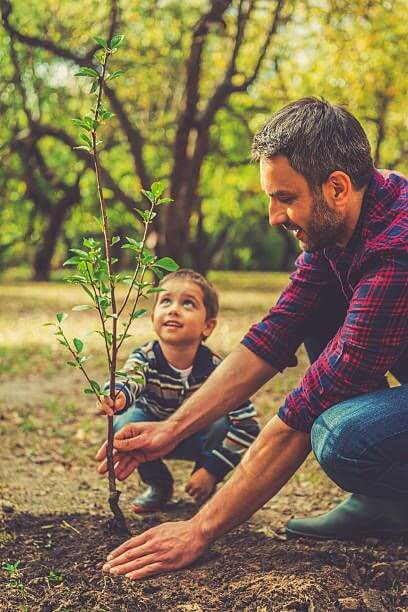Tree Planting Guidelines
Introduction
Planting a tree involves much more than merely making a hole and placing a young tree inside. It’s a nurturing process that brings a multitude of benefits to our environment, economy, and health. In this guide, we’ll explore comprehensive steps and best practices to ensure your tree planting efforts are successful and sustainable.
Why Plant Trees?
Environmental Benefits
Trees are essential in fighting climate change, as they take in carbon dioxide and emit oxygen. They provide habitats for wildlife, reduce soil erosion, and help maintain the water cycle.
Economic Advantages
Trees can increase property values, reduce energy costs by providing shade, and even boost local economies through tourism and recreational opportunities.

Social and Health Benefits
Green spaces enhance the quality of life by offering recreational areas and improving mental health. Trees also help reduce air pollution, leading to better respiratory health for communities.
Planning Your Tree Planting Project
Selecting the Right Tree Species
Choose species that are native to your region as they are more likely to thrive and support local wildlife. Consider the mature size of the tree to ensure it fits well in the intended space Tree Planting Guidelines.
Considering Climate and Soil
Different trees have different needs. Some thrive in acidic soil, while others prefer alkaline conditions. Research the climate and soil requirements of your chosen species.
Determining the Planting Site
Ensure the site has enough space for the tree to grow without interfering with structures or power lines. Consider sun exposure and drainage as well.
Preparing the Planting Site
Clearing the Area
Remove weeds, grass, and debris from the planting site to reduce competition for nutrients and water.
Testing the Soil
Perform an analysis of the soil to ascertain its pH and nutrient content. This will guide any necessary amendments.
Amending the Soil
Add compost or other organic matter to improve soil structure and fertility, making it more conducive to tree growth.
Choosing the Right Time to Plant
Best Seasons for Planting
Typically, the most favorable seasons for tree planting are spring and autumn. These seasons offer moderate temperatures and ample rainfall.
Timing Considerations Based on Region
In some regions, winter or the rainy season may be the optimal time for planting. Avoid extreme heat or cold.
Planting Techniques
Digging the Right Hole
The hole should be two to three times the width of the root ball but no deeper than the root ball itself. This encourages roots to grow outward.
Properly Positioning the Tree
Place the tree in the hole, ensuring the root collar (where the roots meet the trunk) is level with or slightly above the ground.
Backfilling and Watering
Fill the hole with the original soil, breaking up clumsier. Give the soil a good soaking to ensure it settles well and removes any air pockets..
Initial Tree Care
Mulching Techniques
Apply a 2-4 inch layer of mulch around the tree, keeping it away from the trunk to prevent rot and pests Tree Planting Guidelines.
Staking Young Trees
Stake the tree if necessary, using soft ties to support it without damaging the bark. Remove stakes after one to two years.
Immediate Watering Needs
Water the tree deeply and regularly for the first few weeks to help establish roots. Avoid overwatering.
Long-Term Tree Maintenance
Watering Schedule
Establish a watering schedule based on the tree species, soil type, and climate. Deep watering encourages deep root growth.
Fertilization Tips
Fertilize sparingly, as over-fertilization can harm trees. Use a balanced, slow-release fertilizer if necessary.
Pruning Guidelines
Prune trees during the dormant season to shape them and remove dead or diseased branches. Do not excessively prune, as it can cause stress to the tree.
Protecting Your Trees
Pest and Disease Management
Monitor for signs of pests and diseases. Use integrated pest management (IPM) techniques to address issues without harming the environment.
Physical Barriers Against Wildlife
Protect young trees from animals with fencing or tree guards. Deer and rodents can cause significant damage to saplings.
Community Tree Planting Initiatives
Benefits of Community Involvement
Community planting events can foster social bonds and environmental stewardship. They also provide an opportunity to educate the public about the importance of trees.
Organizing a Community Event
Plan the event well in advance, securing necessary permits and gathering volunteers. Provide training on proper planting techniques.
Tree Planting for Urban Areas
Challenges of Urban Planting
Urban environments pose challenges like limited space, pollution, and compacted soil. Trees must be chosen and planted with these factors in mind Tree Planting Guidelines.
Selecting Urban-Friendly Species
Choose species that are resilient to urban stressors. Consider smaller trees or those with non-invasive root systems to avoid infrastructure damage.
Legal and Ethical Considerations
Understanding Local Regulations
Research local ordinances regarding tree planting, especially in urban areas or near property lines. Obtain any required permits.
Ethical Planting Practices
Respect biodiversity by planting a variety of species. Avoid planting invasive species that could disrupt local ecosystems.
Success Stories and Case Studies
Examples of Successful Tree Planting Projects
Highlight projects like New York City’s MillionTreesNYC initiative, which aimed to plant and care for one million new trees.
Lessons Learned
From successful projects, learn about the importance of planning, community involvement, and long-term care in achieving tree planting goals.
Common Mistakes to Avoid
Overplanting and Crowding
Planting too many trees too close together can lead to competition for resources and poor growth. Space trees appropriately based on their mature size.
Ignoring Maintenance
Trees need ongoing care to thrive. Neglecting watering, mulching, and pruning can result in poor health and growth.
Conclusion
Planting a tree is a long-term investment in our planet’s health and our own well-being. By following these guidelines, you can ensure your tree planting efforts are successful and rewarding. So, grab a shovel, gather your friends and family, and start planting!
FAQs
How frequently is it necessary to water a newly planted tree?
Newly planted trees should be watered deeply once or twice a week, depending on rainfall and soil conditions. The aim is to maintain the soil’s moisture without causing it to become oversaturated.
What are the best trees for urban areas?
Trees like the Ginkgo, Red Maple, and Honey Locust are great for urban areas due to their resilience to pollution and compact soil conditions.
How can I protect my tree from pests?
Regularly inspect your tree for signs of pests. Use natural remedies or consult a local arborist for safe pest control methods. Applying a layer of mulch and maintaining tree health can also deter pests.
What is the best soil type for tree planting guidelines?
Most trees prefer well-draining soil with a mix of sand, silt, and clay. Amending soil with organic matter can improve its structure and fertility.
When is the best time of year to plant a tree?
Spring and fall are generally the best times to plant trees due to moderate temperatures and adequate rainfall, which help trees establish roots.
I hope you are having a wonderful day! I have a small favor to
